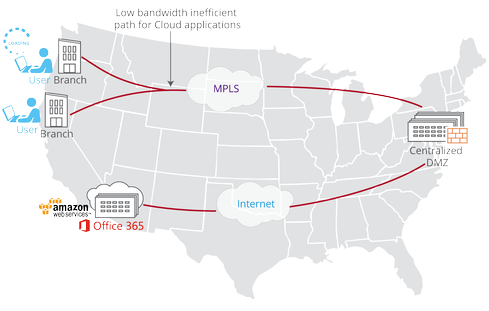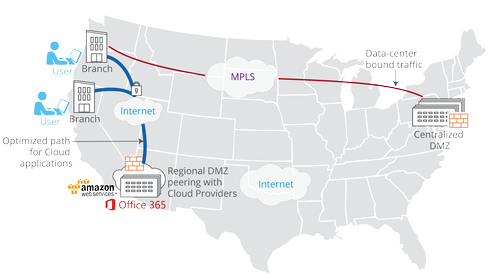One of the most frustrating aspects of the modern enterprise is the poor responsiveness of applications. It doesn't make sense that SaaS applications such as Office365 work better on a home broadband connection than they do on an expensive office connection. This problem extends all the way up to the backbone of the infrastructure: the WAN network architecture.
Legacy multi-protocol label switching (MPLS) network architectures were never designed with SaaS and modern enterprise applications in mind, and it shows. Internet traffic is rising at double-digit rates and now accounts for the majority of enterprise traffic, creating two major drawbacks that degrade application performance for legacy MPLS networks.
Within an enterprise, all Internet traffic has to be backhauled through MPLS to centralized demilitarized zone facilities. This causes the traffic to "trombone," resulting in an inefficient route that increases the distance between user and application. Users encounter the infamous spinning wheel, while the application waits for the network.
Compounding this problem is the lack of bandwidth available to the average branch site. The adoption of SaaS applications, Internet video, and hosted virtual desktop applications creates a need for 10-20 Mbit/s per site, but many branch offices are straddled with a traditional 1.5 Mbit/s. And merely increasing capacity is cost prohibitive using MPLS.
Figure 1:
Poor performance of cloud applications with legacy WANs.
The WAN needs an architectural upgrade to work with the cloud. The solution is a software-defined approach that eliminates the backhauling and lack of bandwidth. First of all, software-defined networks (SDN) will enable enterprises to go beyond MPLS and increase capacity using broadband and LTE links -- with a higher degree of security, due to the robust frameworks of SDN. Streaming video, virtual desktop infrastructure, and cloud applications can easily be deployed without straining the MPLS lines.
The "trombone" problem is eliminated with a new level of control that only SDN architecture makes possible. With regional Internet exits distributed across the geographic footprint of the enterprise, connections to high-bandwidth applications have a much shorter distance to travel.
Performance is further optimized if these exits are located at the cloud provider's peering location. SDN gives enterprises the ability to control data traffic and create the centralized policies to ensure traffic will be directed to the nearest regional exit over high-bandwidth links.
Figure 2:
Optimal performance of cloud applications with SDN in the WAN.
This emerging technology -- termed hybrid WAN or software-defined WAN (SD-WAN) -- was recently voted the top use case for enterprise architects at the Open Networking User Group (ONUG) conference.
Having worked for more than two decades in the networking industry, I'm excited to see SDN bring a level of agility to the WAN that has existed in server virtualization for a while. Finally, the WAN has to be treated the same as the rest of technology -- not as something that can be installed and ignored, but an opportunity for innovation.










